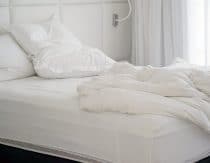
What three things do you need more of in your life? When I asked that question on my Facebook page awhile ago, many of you included deep, restorative sleep as one of your answers. (For some of you, it was all three!)
It makes sense, given that studies show getting good sleep makes us smarter, happier, more productive, more creative, and even keeps us looking younger, yet approximately 1 in 3 of us are chronically sleep deprived. (1) (2) (3) (4) (5) (6) (7)
That’s why a good quality mattress – with its ability to offer both pressure relief and spinal alignment – is literally the foundation of a good night’s sleep. I’ve been sleeping on an Organix mattress by IntelliBed for many years now and it’s still one of the best investments I’ve ever made in my overall well-being.
In this article I’ll explain what makes it totally different than anything else on the market, plus where to find the best pricing available.
Are you getting enough deep sleep? ^
How many hours of sleep do you get most nights? Eight? Seven? Less?
If your answer was less than eight, consider this: In one study conducted by The University of Pennsylvania, researchers divided sleepers into three groups: those who got eight, six, and four hours of sleep.
Not surprisingly, the eight hour group did well on cognitive tests. The four hour group? They scored like a company of blindfolded archers trying to hit a pea while the sky rained down angry ferrets.
But we’re not here to talk about them. We want to talk about the six hour group, which reported that they were tired but had adapted to the loss of sleep. In their assessment, their performance had not been affected.
But objectively, by the end of the two week experiment they demonstrated impaired cognition that was equal to being drunk. (8) Put another way, incremental sleep loss made them about as functional as an individual who had been awake for 24 hours straight, only they didn’t realize how impaired they were. (8)
We continue to live by a remarkably durable myth: sleeping one hour less will give us one more hour of productivity. In reality, the research suggests that even small amounts of sleep deprivation take a significant toll on our health, our mood, our cognitive capacity and our productivity.” – Tony Schwarz, Harvard Business Review (9)
So getting enough sleep is obviously important. But it’s not just about getting sleep – it’s about getting deep, healing sleep.
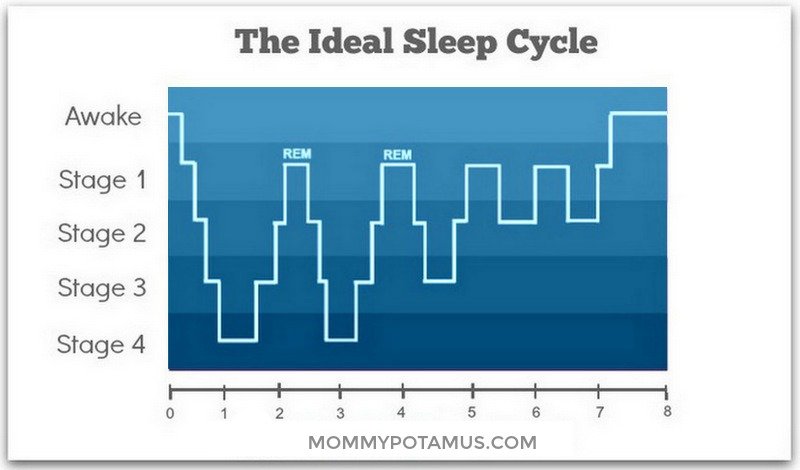
What is healing sleep? ^
As you can see in the graph above, there are four stages of the sleep cycle:
- REM (The stage we dream in)
- Stage 2 (Light sleep that produces fast brain waves)
- Stage 3 and 4 sleep (Deep sleep, also known as Delta sleep)
Delta sleep, which is characterized by high-amplitude, low-frequency delta waves, is when your body does most of its healing work: releasing human growth hormone, repairing tissue, stimulating the production of new cells, etc. This time of rejuvenation is associated with improved memory, decreased depression, and improved immune, nervous and digestive system function.
When we sleep on a bed that creates pressure on our hips, back, and shoulders, we have to move frequently to redistribute our weight. If we don’t, areas under pressure lose circulation and tissue gets damaged.
According to the Mayo Clinic, “Bedsores — also called pressure sores or pressure ulcers — are injuries to skin and underlying tissue resulting from prolonged pressure on the skin.” (10) Obviously, our bodies do whatever it takes to prevent this damage from happening.
Since our bodies don’t typically move around while remaining in Stage 3 and 4 sleep, we have to come up out of deep, restorative sleep back into lighter sleep to shift our weight. These “micro-arousals” may inhibit or stop the release of human growth hormone during deep sleep. (11)
So for me, healing sleep means more time in Stage 3 and 4 sleep, aka “repair mode.”
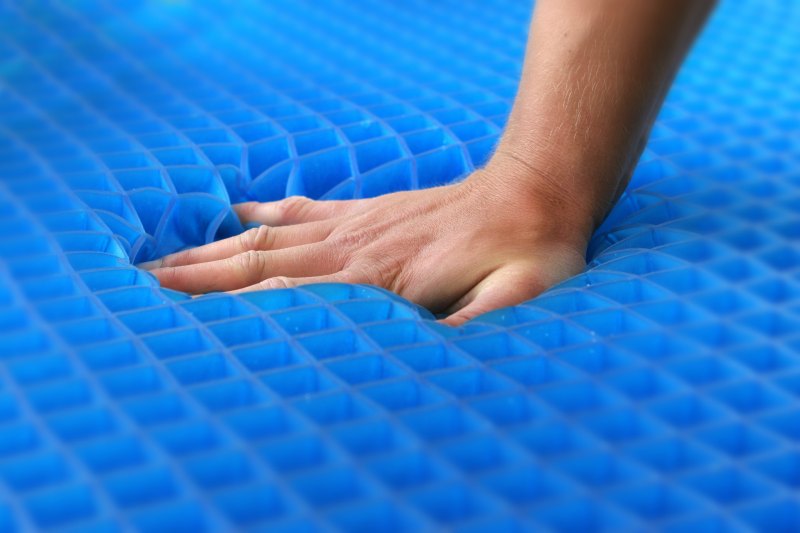
Why The Organix Mattress Is Different ^
If you frequently shift your weight while you sleep, you may not be getting enough of the deepest, most restorative levels of sleep your body needs.
Most mattresses aim for one of two goals: softness (pressure relief) or firmness (for optimal spinal alignment). Both are important because too much pressure will cause you to have to shift more often (pulling you out of the deeper stages of sleep) and poor spinal alignment can impact the central nervous system and lead to joint/muscle pain.
By incorporating a patented Gel Matrix™ that is used in hospitals to cushion severe wound care patients, the Organix bed offers something that makes it the rare unicorn of mattress: it’s both pressure relieving (soft) and supportive of optimal spinal alignment (firm).
Here’s what I mean: In the photo below, you see the same person laying on four types of mattresses, including one with the patented Gel Matrix™.
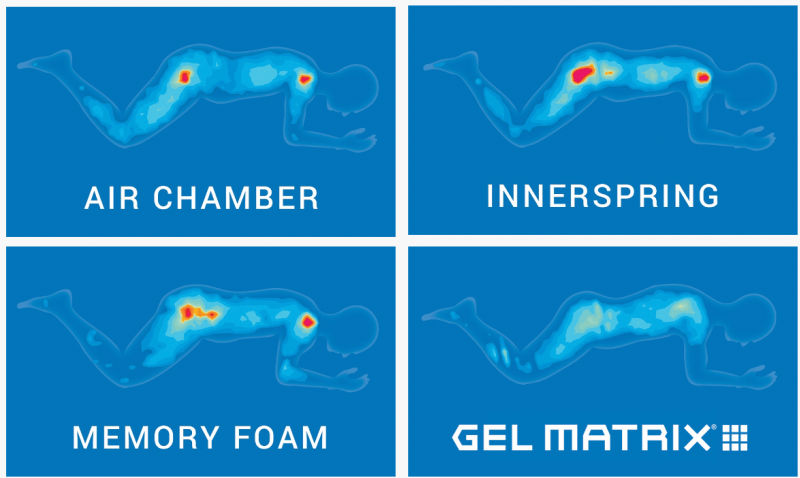
Using a medical grade pressure mapping system, the results show that the Gel Matrix™ reduces pressure on the hips and shoulders, which in many cases can extend the time we can comfortably stay in deep, healing sleep. Anything over blue signifies enough pressure to cause an individual to need to move within five minutes.
At the same time, the inner construction of the bed supports postural alignment in a way that most soft beds can’t. Because of this unique combination, you get the benefits of both a soft (deeply pressure relieving) AND firm (supportive) mattress in one.
Here’s an overview of the bed from Dr. Robert Troell, a Stanford educated surgeon who is also board-certified in sleep medicine.
Problems With Conventional Mattresses ^
Back when I first compiled my ideal mattress criteria, I was mostly looking for a non-toxic materials. I didn’t want a repeat of what happened when my husband and made our first purchase together as newlyweds – a top-of-the-line memory foam mattress. The moment we brought it into our home I started feeling nauseous, and I couldn’t sleep in our room for over a week due to headaches and queasiness.
Though it wasn’t the only factor, that experience is what led me to start re-evaluating the products I was bringing into my home. I cleaned up my diet, started making my own cleaning products and personal care products, and eventually saved up enough to buy a non-toxic mattress.
What I learned as I began researching better options is that companies routinely add a variety of chemicals to achieve certain qualities – such as foam “memory” and fire resistance – in their mattresses. Many of these chemicals pose serious health risks – let’s take a look at two of the main categories:
Flame Retardants
In a this study, researchers found that exposure to PDBE flame retardants cost children 162 million IQ points between 2001 and 2016. They concluded that PDBE flame retardant exposure had a more negative impact on IQ than lead, mercury, and organophosphate (pesticide) exposure combined.
Also, chlorinated tris – which is currently being used in increasing amounts due to PDBE’s being phased out – was banned in children’s pajamas more than thirty years ago after it was found to cause cancer in test animals. (12) (13)
And that’s not the only problem associated with flame retardants – they’ve been linked to an increased risk of reproductive problems, thyroid dysfunction, fetal growth problems, and more. According the the Journal of Exposure Science & Environmental Epidemiology, chlorinated tris and other chemicals are now being detected in the dust found in homes.
Volatile Organic Compounds
Volatile organic compounds (VOCs) such as formaldehyde and benzene are also often present in many conventional mattresses, even crib mattresses. As I cover in more detail in this article on reducing VOCs around the home, exposure has been linked to significant short-term and long-term health effects.
Children are especially vulnerable to the impact of these chemicals, yet they are the ones that spend 12-16 hours a day with their faces near the surface of the mattress. If there’s anything we learned from PDBE’s, it’s the frustrating reality that these dust particles are likely to bioaccumulate. (12)

My littlest one decided to demonstrate my point about babies sleeping with their faces smooshed against the mattress by taking a nap during my photo shoot.
What materials are in the Organix mattress? ^
When I set out to buy a non-toxic mattress I was really only looking at the materials used, but along the way I came to believe that beds ability to relieve pressure was just as important as what it’s made of.
Less pressure means we can stay asleep in the same position longer, and hopefully stay in those deep levels of healing regenerative sleep once we’ve reached them. Our lives are so full of unavoidable stressors these days, it seems to me that it’s more crucial than ever to make sure we get the best sleep possible.
With that said, I wasn’t willing to compromise on materials either, and with the Organix bed I didn’t have to. Here’s what it’s made of:
Gel Matrix™ Layer
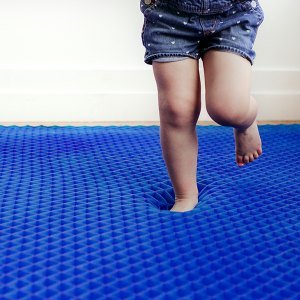
Although IntelliGel is neither natural nor organic, the copolymer gel it’s made from is non-toxic, hypoallergenic, antimicrobial, non-offgassing, and solely licensed to IntelliBed for use in commercial products. It’s also highly durable and pressure relieving.
When my mattress first arrived, I noticed immediately that unlike the “new bed smell” I have experienced before, it had no chemical smell at all fresh out of the box. I am very chemically sensitive, but I mashed my face into the mattress and could not smell a thing.
A few years after recommending this mattress, I bought a plane ticket and flew to their manufacturing facility in Utah to inspect beds that were in various stages of production. Everybody I spoke with was completely open and ready to show me what they were working on, and nobody was wearing masks. I thought that was interesting so I commented on it, and they gave me a VOC air quality meter to check things out.
I walked around and took readings right next to the raw materials, including the Gel Matrix layer as it was coming off the press. Not only was the VOC count extremely low – it was LOWER than when we measured in their administrative offices due to off-gassing carpets and office furniture. I’m talking measurements between 0.07-0.08, which is excellent.
After I finished measuring everything, some of the craftsmen invited me to test how strong and flexible the Gel Matrix™ is by sitting in it.
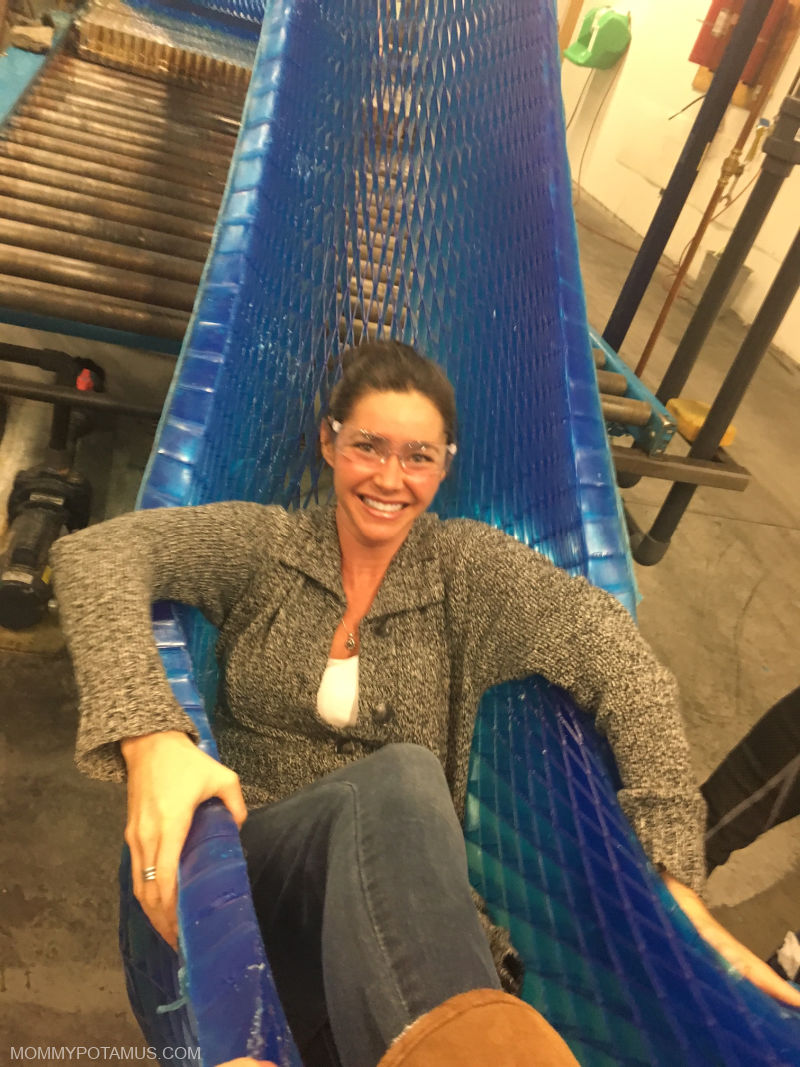
Green Fireblocker
The fireblocker used is called Firegard. It’s GreenGuard Gold certified, which means that Underwriters Laboratories (a highly respected organization) has tested it and verified that it is low-VOC. GreenGuard tests for tens of thousands of VOC’s and gave Firegard its highest rating.
I requested (and received) a copy of their flammability tests (which were done by Intertek, an independent third party) and it’s clear that their fire blocker far exceeds industry standards in performance.
CertiPUR Foam Layer
There’s also a Serene Comfort Layer made from polyurethane foam to add extra cushion. Unlike some polyurethane foams which have additional chemicals added to create certain effects like “memory,” the foam in the Organix is:
- Made without ozone depleters
- Made without PBDEs, TDCPP or TCEP (“Tris”) flame retardants
- Made without mercury, lead and heavy metals
- Made without formaldehyde
- Made without phthalates regulated by the Consumer Product Safety Commission
- Low VOC (Volatile Organic Compound) emissions for indoor air quality (less than 0.5 parts per million)
Three-Zone Pocket Coil System
Unlike the open coil mattresses most of us grew up with, pocket springs are individually wrapped springs that move independently of each other. That allows the mattress to be more responsive while minimizing motion transfer. As a bonus, they’re more durable, too.
And because I know you might be wondering, I’m going to weigh in on the issue of springs and EMFs later in this article.
Organic Cotton
After construction, the entire mattress is wrapped in an organic cotton cover.

5 Reasons I Chose An Organix Mattress ^
1. Structurally aligns your spine, which is why the technology is recommended by over 1.400 orthopedic surgeons, spinal specialists and chiropractors.
2. Takes pressure off your body so you can sleep in the same position longer, allowing for more stage 3 and stage 4 sleep. These deep levels of sleep needed for healing, cellular repair, and detoxification.
3. Made with non-toxic materials so you aren’t sleeping on a surface that is off-gassing.
4. Value and durability because it comes with a 20-year warranty (more on that below).
5. No continuous coil innerspring. Some experts have raised concerns about continuous coil spring mattresses potentially acting as an “antennae” that amplifies electromagnetic frequencies (EMFs). Organix uses a pocketed coil meaning that each coil is wrapped in fabric and sewn together. They function independently and are not interconnected in any way, and when I measured them with my EMF meter I was not able to detect any difference between the pocketed coils and the rest of my sleep environment.
A Note On Value & Durability ^
When my husband and I were newlyweds, we invested in a top-of-the-line memory foam mattress. It smelled strongly of chemicals when it arrived – in fact, we had to leave the windows open in the bedroom for several days before I could even sleep in there without becoming nauseous. Looking back, I believe that the VOCs emitted by that bed contributed to the health issues I developed during our first year of marriage. It wasn’t the only factor, but it certainly didn’t help.
That wasn’t the only issue, though. In terms of value, we got ten years out of that bed, but we didn’t get our money’s worth for that entire decade. I was pregnant with my first child two years after purchase. My second baby came along three years later. Around that time I noticed that the bed felt different, which I now know was a sign that the memory foam was breaking down and compressing.
My littlest came three years after that. During the last few weeks of that pregnancy, the mattress had significantly deteriorated in comfort. I was experiencing so much pressure while sleeping on my side that I began waking up with bruises on my hips. I had to make a conscious effort to wake up and turn over more often.
So we had the mattress for ten years, but it didn’t actually last that long in terms of comfort.
Since the goal is deep, restorative sleep, it would be good to know how long a mattress will last in its ideal condition, and then divide the cost of the mattress by the number of years and/or months of optimal condition to determine the cost of a really good sleep.
At somewhere in the ballpark of $4000, my queen-size memory foam really cost me $800 a year for the five years it was mostly comfortable. And that includes all the noxious fumes I had to breathe during that time. That’s a pretty big cost for such a significant downside.
Organix by IntelliBed has shown in third-party durability testing that it only softens about 4.5% over the life of the mattress, which is warrantied to last in optimal sleeping condition for 20 years. So for the Tranquiliti model, that’s about $275 a year. My family covers the cost of each year in what we save from chiropractic visits.
Watch The Replay ^
To take a deeper dive into all things mattress, click the video below for a webinar that I recorded with Jason Payne, the founder of Organix. It’s full of great info that’s well worth sharing with family members or anyone considering a mattress purchase.
How To Save On An Organix Mattress ^
Right now, Organix by IntelliBed is offering a discount and exclusive gift just for you guys.
Use the coupon code MOMMYPOTAMUS at this link to get 10% off an IntelliBed Organix mattress PLUS a:
- Free weighted blanket (One of my highest rated recommendations in this article on the benefits of weighted blankets)
- Free mattress protector
- Free shipping
Use code MOMMYPOTAMUS to save here
Question? Leave a comment below!
Sources
1. Scientific American (2008) Sleep On It: How Snoozing Makes You Smarter
2. PBS (2012) Can Sleep Make You Smarter?
3. BBC (2013) How Sleep Makes Your Mind More Creative
4. American Psychological Association (2014) Sleep Deprivation: More Sleep Would Make Most Americans Happier, Healthier and Safer.
5. Stump, Scott (2013) “Nap Rooms” Encourage Sleeping On The Job To Boost Productivity
6. Harris, Shelby (2013) Sleep and Longevity: 5 Ways Sleep Keeps You Young
7. Centers for Disease Control and Prevention (2016) 1 in 3 adults don’t get enough sleep
8. Jones, Maggie (2011) How Little Sleep Can You Get Away With?
9. Harvard Business Review (2011) Sleep Is More Important Than Food
10. Mayo Clinic. Bedsores (Pressure Ulcers)
11. Cline, John (2010) The Mysterious Benefits of Deep Sleep
12. Lakind, Judy and Birnbaum, Linda (2010) Out of the frying pan and out of the fire: the indispensable role of exposure science in avoiding risks from replacement chemicals
13. Consumer Product Safety Commission. CPSC Bans TRIS-Treated Children’s Garments


